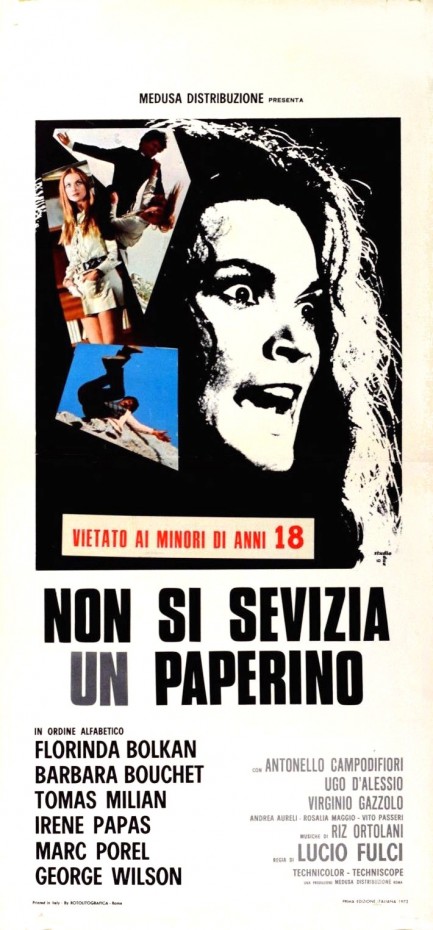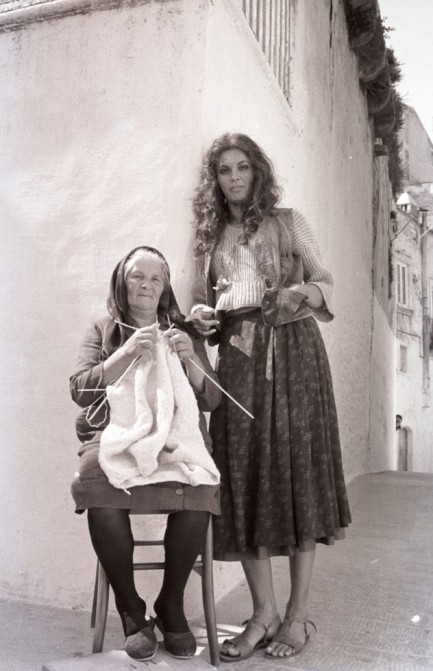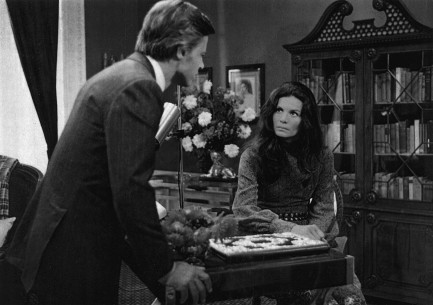 She looks serene but she's about to erupt.  
These shots of Brazilian model and actress Florinda Bolkan, née Florinda Bulcão, were made in 1968 when she was appearing in her first film Candy. Bolkan would leverage that role into a movie career in Europe by headlining such films as Una lucertola con la pelle di donna, aka A Lizard in Woman's Skin, Indagine su un cittadino al di sopra di ogni sospetto, aka Investigation of a Citizen Above Suspicion, and Non si sevizia un paperino, which we just talked about. For a time Bolkan was one of the hottest properties on the continent, and in Italy she was a virtual Vesuvius, with performances ranging from giallo to comedy garnering her acclaim that led to several international awards. All from humble beginnings on this beach. Read a bit more about her movie roles here and here.
 What's mostly style and virtually no logic? A typical giallo. 
Giallo films occasionally take on taboo subject matter. In western cinema little is more taboo than child murder. Non si sevizia un paperino, aka Don't Torture a Duckling unabashedly uses this premise, as police in rural Italy try to solve the murder of a 12-year-old named Bruno. “The guy's obviously going to be a mental case,” one cop says. “The killer's a maniac,” says another. But cops are notoriously obtuse in these films. Was the killer really some nut job? Bruno was one of a trio of close friends who spent a lot of time together playing in the hills. When a second member of the group turns up dead it seems clear that the three boys saw something they shouldn't have and are now being targeted.
As usual in giallo there are extraneous moments littered throughout the plot. Why does creepy ass Florinda Bolkan play in the muck with three voodoo dolls that seem to represent the three boys? Why does a local farmer wander the woods during a late night thunderstorm chopping down foliage with a machete? Why does Barbara Bouchet lounge in her room nude under a sun lamp? Actually, we know the answer to that last question—the filmmakers had one of cinema's great beauties on their hands and weren't about to let the opportunity to show her pass. We couldn't let it pass either. See the promo images below.
Getting back to the positives, we enjoyed watching sex symbol Bolkan dirty herself up to play a mountain witch, loved Bouchet's assortment of ultra cool outfits and cars, and thought the filmmakers used the Basilicata countryside to good effect. But who did the killing? Was it Bolkan the witch? The big city drug addict? The handsome local priest? The mentally disabled man-boy? The priest's strange mother? Giallo mysteries are not usually written in such a way as to be solvable, so in truth it's hard to care. But even if Non si sevizia un paperino isn't an involving puzzle, it's great eye candy with a bizarrely graphic ending that must be seen to be believed. It premiered in Italy today in 1972.           
 Florinda Bolkan is a textbook case of multiple epidermal disorder.  
Una lucertola con la pelle di donna premiered in Italy in 1971 and in the U.S. as Lizard in a Woman's Skin today in 1973. It's a giallo—i.e. a thriller with mystery, slasher, detective, and psychological horror elements. Brazilian actress Florinda Bolkan stars, and she has a problem—she's having erotic dreams about her beautiful neighbor Anita Strindberg. The dreams disturb and arouse Bolkan, but she's working out her concerns in therapy. All well and good, until matters take a turn for the worse when she dreams about dispatching Strindberg with a knife, and later wakes to find that Strindberg has indeed been murdered in the exact fashion as in her nightmare.
The cops arrest her for the killing and send her to a mental hospital to await trial. But the case is hardly airtight. Loose ends include Bolkan's dream diary, an illicit affair, and a blackmail plot. The mental hospital is hardly airtight either. A stalker shows up intent on putting Bolkan out of commission. Eventually doubts arise in the case and Bolkan is sprung from the booby hatch, but who committed the murder? Well, below we have some production shots, and at bottom is a poster for the film's re-issue as Schizoid—a title that's a blatant spoiler. Actually, considering lizards change their skin by molting, the original title is a spoiler as well. Too clever by half, these Italian filmmakers, but the movie is still fun.                        
 Reiko Ike makes her presence felt in Rome. 
Reiko Ike appears here in a bold photo published in the French magazine Euro Cinéma in November 1972. The text reads: A beautiful oriental pearl came to Rome for the turn Toei’s “A modern biography.” What does that mean? Unfortunately, our translating widget cannot clear that up. Seems as though the magazine is telling us Ike was sent to Rome earlier that year to promote either one of her own films, films by her studio Toei Company, or both. We found no references to anything made by Toei called A Modern Biography, and nothing that would translate to such. Our guess is the name refers to a Japanese film festival in Rome they put together or participated in. Anyone out there want to clear this up? You know the drill—editor@pulpinternational.com. Anyway, what’s extra cool about this magazine is that it also has Christina Lindberg on the cover and inside, plus Florinda Bolkan and Laura Antonelli. Euro Cinéma is good cinema.

 She looks about ready to shed her skin. 
We ran across this nice piece of art made for a special screening of Lucio Fulci's 1971 giallo Una lucertola con la pelle di donna, aka Lizard in a Woman's Skin. The film is showing this evening at the Prince Charles Theatre in London under the auspices of Cigarette Burns, a film society that has brought vintage movies to The Barbican Centre, the Leeds International Film Festival, the Duke of York’s in Brighton and other locales. The star of this promo art—and of the movie as well—is Brazilian actress Florinda Bolkan, and we love her outfit. We haven't seen Una lucertola con la pelle di donna yet, but we'll get around to it in due time (update: we watched it, though several years later—you can see what we wrote about it here). If you're in London or environs, here's a chance to see a classic giallo on a big screen. In the meantime, below you see a clean version of the image used in the promo art, as well as a shot of Bolkan wearing the same clothes while standing. We can only hope she fired her tailor, because her outfit isn't even properly sewn. Or maybe it's supposed to be that way. With fashion who can tell?   
|
 |

The headlines that mattered yesteryear.
1933—The Gestapo Is Formed
The Geheime Staatspolizei, aka Gestapo, the official secret police force of Nazi Germany, is established. It begins under the administration of SS leader Heinrich Himmler in his position as Chief of German Police, but by 1939 is administered by the Reichssicherheitshauptamt, or Reich Main Security Office, and is a feared entity in every corner of Germany and beyond. 1937—Guernica Is Bombed
In Spain during the Spanish Civil War, the Basque town of Guernica is bombed by the German Luftwaffe, resulting in widespread destruction and casualties. The Basque government reports 1,654 people killed, while later research suggests far fewer deaths, but regardless, Guernica is viewed as an example of terror bombing and other countries learn that Nazi Germany is committed to that tactic. The bombing also becomes inspiration for Pablo Picasso, resulting in a protest painting that is not only his most famous work, but one the most important pieces of art ever produced. 1939—Batman Debuts
In Detective Comics #27, DC Comics publishes its second major superhero, Batman, who becomes one of the most popular comic book characters of all time, and then a popular camp television series starring Adam West, and lastly a multi-million dollar movie franchise starring Michael Keaton, then George Clooney, and finally Christian Bale. 1953—Crick and Watson Publish DNA Results
British scientists James D Watson and Francis Crick publish an article detailing their discovery of the existence and structure of deoxyribonucleic acid, or DNA, in Nature magazine. Their findings answer one of the oldest and most fundamental questions of biology, that of how living things reproduce themselves. 1967—First Space Program Casualty Occurs
Soviet cosmonaut Vladimir Komarov dies in Soyuz 1 when, during re-entry into Earth's atmosphere after more than ten successful orbits, the capsule's main parachute fails to deploy properly, and the backup chute becomes entangled in the first. The capsule's descent is slowed, but it still hits the ground at about 90 mph, at which point it bursts into flames. Komarov is the first human to die during a space mission.
|

|
|

It's easy. We have an uploader that makes it a snap. Use it to submit your art, text, header, and subhead. Your post can be funny, serious, or anything in between, as long as it's vintage pulp. You'll get a byline and experience the fleeting pride of free authorship. We'll edit your post for typos, but the rest is up to you. Click here to give us your best shot.

|
|























































































































